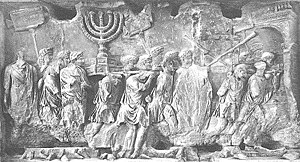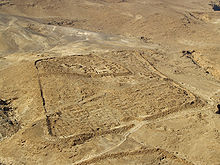|
First Jewish-Roman War "Great Revolt"
Bronze Prutah 17mm (2.6 grams)
Year II of the Jewish War Jerusalem mint: 67-68 A.D.
Reference: Hendin 661
Obverse: Amphora with broad rim and two handles; around Hebrew inscription for
Year 2.
Reverse: Vine leaf on a branch and the Hebrew inscription: 'The Freedom of
Zion'.
* Reference: You are bidding on an authentic coin struck by
the Jews revolting in Jerusalem, which led to the sacking and destruction of the
Second Temple.
You are bidding on the exact item pictured,
provided with a Certificate of Authenticity and Lifetime Guarantee of
Authenticity.
The first Jewish-Roman War (66–70), sometimes called
The Great Revolt (Hebrew:
המרד הגדול, ha-Mered Ha-Gadol),
was the first of three
major rebellions by the Jews of the
Iudaea Province (Judea Province), against the
Roman
Empire (the second was the
Kitos War
in 115–117 CE; the third was
Bar Kokhba's revolt, 132–135)CE.
It began in the year 66 initially because of Greek and Jewish religious
tensions but grew with anti-taxation protests and attacks upon Roman citizens.[1]
It ended when
legions
under Titus
besieged and destroyed the centre of rebel resistance in
Jerusalem,
and defeated the remaining Jewish strongholds.
Outbreak
of the Rebellion
According to
Josephus, the revolt, which began at
Caesarea in 66, was
provoked by Greeks sacrificing birds in front of a local
synagogue.[2]
The Roman garrison did not intercede and the long-standing Greek and Jewish
religious tensions took a downward spiral. In reaction, the son of
Kohen
Gadol (High priest)
Eliezar ben Hanania ceased prayers and sacrifices for the
Roman
Emperor at the Temple. Protests over taxation joined the list of grievances
and random attacks on Roman citizens and perceived 'traitors' occurred in
Jerusalem. Fearing the worst, the pro-Roman king
Agrippa II
and his sister
Berenice fled Jerusalem to
Galilee.
Cestius Gallus, the
legate of
Syria, brought a legion, the
XII Fulminata, and auxiliary troops as reinforcements to restore order. They
were defeated in an ambush at the
Battle of Beth Horon, a result that shocked the Roman leadership.
The
Roman response
Emperor Nero
appointed general
Vespasian
instead of Gallus to crush the rebellion. Vespasian, along with legions
X Fretensis and
V Macedonica, landed at
Ptolemais in April 67. There he was joined by his son
Titus, who
arrived from
Alexandria
at the head of
Legio XV Apollinaris, as well as by the armies of various local allies
including that of king
Agrippa II.
Fielding more than 60,000 soldiers, Vespasian began operations by subjugating
the Galilee[3].
Many towns gave up without a fight, although others had to be taken by force. Of
these, Josephus
provides detailed accounts of the sieges of
Yodfat and
Gamla. By the
year 68, Jewish
resistance in the North had been crushed, and Vespasian made
Caesarea Maritima his headquarters and proceeded to methodically clear the
coast.
The leaders of the collapsed Northern revolt,
John of Giscala and
Simon Bar Giora, managed to escape to Jerusalem. Brutal civil war erupted,
the
Zealots and the fanatical
Sicarii
executed anyone advocating surrender, and by
68 the entire
leadership of the southern revolt was dead,[citation
needed] killed by Jewish hands in the infighting, some at the
Zealot Temple Siege.
New
Emperor
While the war in Judea was being won, great events were occurring in Rome. In
the middle of 68 AD, the emperor Nero's increasingly erratic behaviour finally
lost him all support for his position. The
Roman
Senate, the
praetorian guard and several prominent army commanders conspired for his
removal. When the senate declared Nero an enemy of the people, he fled Rome and
committed suicide. The newly installed emperor
Galba was
murdered after just a few months by a
rival, triggering a
civil war that came to be known as the
Year of the Four Emperors. In 69 AD, though previously uninvolved, the
popular
Vespasian was also hailed emperor by the legions under his command. He
decided, upon gaining further widespread support, to return to Rome to claim the
throne from the usurper
Vitellius,
leaving his son Titus
to finish the war in Judea.
Fall
of Jerusalem
The siege of Jerusalem, the capital city, had begun early in the war, but had
turned into a stalemate. Unable to breach the city's defenses, the Roman armies
established a permanent camp just outside the city, digging a trench around the
circumference of its walls and building a wall as high as the city walls
themselves around Jerusalem. Anyone caught in the trench attempting to flee the
city would be captured,
crucified, and placed in lines on top of the dirt wall facing into
Jerusalem. The two Zealot leaders,
John of Gischala and
Simon Bar Giora, only ceased hostilities and joined forces to defend the
city when the Romans began to construct ramparts for the siege. Those attempting
to escape the city were crucified, with as many as five hundred crucifixions
occurring in a day.[4]
Titus Flavius,
Vespasian's son, led the final assault and
siege of Jerusalem. During the infighting inside the city walls, a
stockpiled supply of dry food was intentionally burned by Jewish leaders to
induce the defenders to fight against the siege instead of negotiating peace; as
a result many city dwellers and soldiers died of starvation during the siege.
Zealots under
Eleazar ben Simon held the Temple,
Sicarii led
by Simon Bar Giora held the upper city. Titus eventually wiped out the last
remnants of Jewish resistance.[citation
needed]

The treasures of Jerusalem taken by the Romans (detail from the
Arch of Titus).
By the summer of 70, the Romans had breached the walls of Jerusalem,
ransacking and burning nearly the entire city. The Romans began by attacking the
weakest spot which was the third wall. It was built shortly before the siege so
it did not have as much time invested in its protection. They succeeded towards
the end of May and shortly afterwards broke through the more important second
wall. The
Second Temple (the rennovated
Herod's Temple) was destroyed on
Tisha B'Av
(29 or 30 July 70).
Tacitus, a
historian of the time, notes that those who were besieged in Jerusalem amounted
to no fewer than six hundred thousand, that men and women alike and every age
engaged in armed resistance, everyone who could pick up a weapon did, both sexes
showed equal determination, preferring death to a life that involved expulsion
from their country.[citation
needed] All three walls were destroyed and in turn so was the
Temple, some of whose overturned stones and their place of impact can still be
seen. John of Giscala surrendered at
Agrippa II's
fortress of Jotaphta and was sentenced to life imprisonment. The famous
Arch
of Titus still stands in Rome: it depicts Roman legionaries carrying the
Temple of Jerusalem's treasuries, including the
Menorah, during
Titus's
triumphal procession in
Rome.[citation
needed]
Fall
of Masada

Remnants of one of several legionary camps at
Masada
in
Israel, just outside the
circumvallation wall which can be seen at the bottom of the
image.
During the spring of 71, Titus set sail for Rome. A new military governor was
then appointed from Rome,
Lucilius Bassus, whose assigned task was to undertake the "mopping-up"
operations in Judaea. He used X Fretensis to besiege and capture the few
remaining fortresses that still resisted. Bassus took
Herodium,
and then crossed the Jordan to capture the fortress of
Machaerus
on the shore of the
Dead Sea.
Because of illness, Bassus did not live to complete his mission.
Lucius Flavius Silva replaced him, and moved against the last Jewish
stronghold, Masada,
in the autumn of 72. He used
Legio X, auxiliary troops, and thousands of Jewish prisoners,[citation
needed] for a total of 10,000 soldiers. After his orders for
surrender were rejected, Silva established several base camps and circumvallated
the fortress. According to
Josephus,
when the Romans finally broke through the walls of this citadel in 73, they
discovered that the 967 defenders had all committed suicide, preferring death
over defeat.
The
outcome
The defeat of the Jewish revolt altered the
Jewish diaspora, as many of the Jewish rebels were scattered or sold into
slavery.
Josephus claims that 1,100,000 people were killed during the siege, a sizeable
portion of these to illnesses brought about by hunger. "A pestilential
destruction upon them, and soon afterward such a famine, as destroyed them more
suddenly."[5]
97,000 were captured and enslaved[5]
and many others fled to areas around the
Mediterranean.
The
Jewish Encyclopedia article on the Hebrew Alphabet states: "Not until the
revolts against Nero and against Hadrian did the Jews return to the use of the
old Hebrew script on their coins, which they did from similar motives to
those which had governed them two or three centuries previously; both times, it
is true, only for a brief period."[6]
Titus reportedly refused to accept a wreath of victory, as there is "no merit
in vanquishing people forsaken by their own God".[7]
Before Vespasian's departure, the
Pharisaic sage and
Rabbi
Yohanan ben Zakkai obtained his permission to establish a
Judaic school at Yavne. Zakkai was smuggled away from Jerusalem in a coffin
by his students. Later this school has become a major center of
Talmudic study.
(See Mishnah)
Sources
The main account of the revolt comes from
Josephus,
the former Jewish commander of
Galilee, who
after capture by the Romans, attempted to end the rebellion by negotiating with
the Judeans on Titus's behalf. Josephus and Titus became quite close friends and
later Josephus was granted
Roman citizenship and a pension.[citation
needed] He never returned to his homeland after the fall of
Jerusalem, living in Rome as an historian under the patronage of Flavius and
Titus.
He wrote two works,
The
Jewish War (c. 79) and
Jewish Antiquities (c. 94) on occasions contradictory. These are the
only surviving source materials containing information on specific events
occurring during the fighting. But the material has been questioned because of
claims that cannot be verified by secondary sources. Only since the discovery of
the
Dead Sea scrolls has some solid confirmation been given to the events he
describes.
|